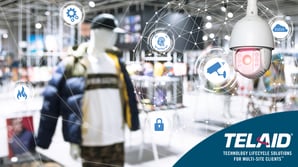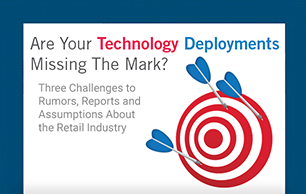 With visions of increased throughput, efficiency and profitability, forward-thinking retailers are eagerly pursuing the path to automation. Retail automation conjures visions of high-tech distribution and micro-fulfillment centers teeming with robots, drones and conveyor systems that effortlessly and accurately deliver items to just the right place at the right time. Or perhaps the picture entails smiling customers walking out with their hot food order instantly without having to stop to pay.
With visions of increased throughput, efficiency and profitability, forward-thinking retailers are eagerly pursuing the path to automation. Retail automation conjures visions of high-tech distribution and micro-fulfillment centers teeming with robots, drones and conveyor systems that effortlessly and accurately deliver items to just the right place at the right time. Or perhaps the picture entails smiling customers walking out with their hot food order instantly without having to stop to pay.
It's not that these visions are inaccurate; it’s that many enterprises don’t realize the type of planning, investment and the collaborative ecosystem required to achieve a fully automated environment. Automation projects are extremely complex and differ significantly from other technology deployments.
Here are five common myths about pursuing the path to retail automation that can delay or derail your vision.
Myth #1 – It’s like any other technology deployment
Automation is complicated, largely because it typically involves multiple unified technologies functioning as a single system. As a result, it does not resemble device-specific deployments or simple integrations. As an example, frictionless checkout requires supporting infrastructure that includes dozens of precisely deployed cameras with computer vision that connect seamlessly with the POS system, which then generates an automated receipt for the shopper on their phone. This type of deployment requires planning, sometimes extensive infrastructure upgrades and a team of vendors.
Myth #2 – Vendors can offer a turnkey solution
Single-vendor solutions are quickly becoming extinct, as integrations get more complex. Software vendors may not have the expertise to understand which hardware best supports functionality and scalability in light of network considerations. Likewise, hardware providers need to be able to support software providers selected by their customers. Increasingly, enterprises are partnering with an entire ecosystem of partners to realize a unified solution. If your vendor doesn’t want to work with others, it should raise a red flag.
Myth #3 – Solutions are easily scalable
Automating processes can feel like boiling the ocean. Use cases for advanced technologies like computer vision or predictive analytics may be under development, only to be realized once users experience the power of the technologies for themselves. Time and time again, we’ve seen companies pinpoint a single use case and deploy for that specific application. However, once they realize the power of computer vision, for example, they quickly add other applications to the list. When that happens, it’s not just a matter of adding a few cameras. Bandwidth and processing quickly become an issue as well as different types of cameras that may be required to achieve certain goals such as license plate recognition or safe use in kitchen areas where there may be elevated temperatures. It’s best to map out phases 1,2 and 3 prior to rollout to anticipate future system expansion.
Myth #4 – I’ll achieve ROI in one year
Everyone wants a quick ROI and it’s true that automation technologies can truly revolutionize the business. However, systems are extensive and expensive. When planning for automation, teams need to be realistic about the timeframe of their achievements and the payback period. In addition, many businesses make the mistake of thinking automation will achieve optimal performance on day one. Most often, there is a period of adjustment before the system achieves its intended goals.
Myth #5 – I think I thought of everything
The more planning you engage in, the better, but the truth is, it’s virtually impossible to think of everything. This type of dynamic technology deployment is going to involve surprises along the way. There are dozens of fire and safety compliance issues that differ by country, state and even locality. Impacts on employees may not be the ones anticipated and even space and location of automation technologies may reveal challenges. Change management within your organization is also critical to ensuring the smooth integration of new retail automation systems.
While it’s impossible to anticipate every pitfall, you can select partners who are skilled in project management, collaboration with other stakeholders and complex deployments. At Telaid, we specialize in those things. Check out our guide to Pioneering New Frontiers in Automation for more tips and insights as you move toward automation.




